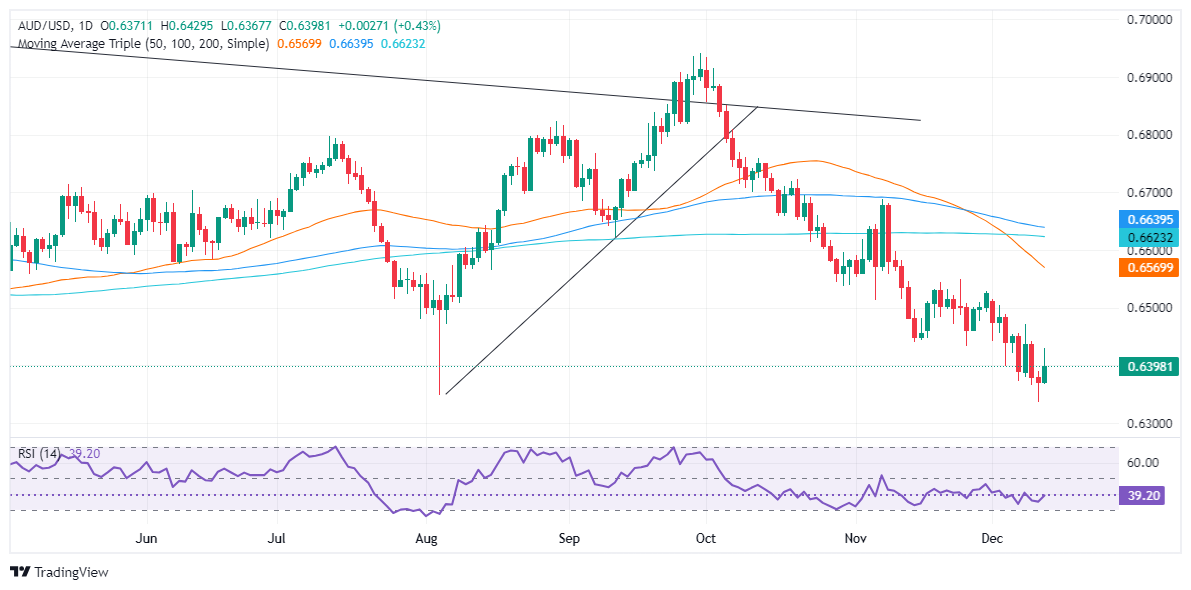AUD/USD gains as US jobs data points to Fed easing
- AUD/USD rises to 0.6392, buoyed by weak US labor market reports
- US Initial Jobless Claims hit a two-month high, fueling speculation of continued Fed policy easing.
- Australian employment exceeds expectations with 35.6K jobs added in November, unemployment dips to 3.9%.
The Australian Dollar recovers some ground on Thursday against the Greenback, following the release of US jobs data. The US Bureau of Labor Statistics (BLS) revealed that the labor market is weakening further, suggesting that the Federal Reserve may continue to ease policy. the AUD/USD trades at 0.6392, up by 0.36%.
AUD/USD trimmed its gains after mixed US economic data
The BLS revealed that Initial Jobless Claims for the week ending December 7 jumped to a two-month high of 242K, exceeding estimates of 220K, according to Bloomberg. At the same time, the Producer Price Index (PPI) for November revealed by the same government agency showed that headline inflation in the producer side rose by 3% YoY, up from 2.4%, above forecasts of 2.6%, while Core PPI increased by 3.4% YoY, exceeding projections of 3.2%, up from 3.1%.
After the data, the American currency failing to gain traction. The US Dollar Index (DXY), which tracks the performance of the buck against other six currencies, remains firm at 106.79, up 15%.
During the Asian session, Australian Employment figures for November, crushed estimates of 25K, coming at 35.6K, while the Unemployment Rate, ticked lower from 4.1% to 3.9%, beneath forecasts of 4.2%.
The swaps market trimmed odds for a February rate cut to 50%, down from 70% ahead of the data. Nevertheless, the RBA adopted a mor dovish stance, saying “the Board is gaining some confidence that inflation is moving sustainably towards target.”
AUD/USD Price Forecast: Technical outlook
The AUD/USD rose sharply and print a daily high of 0.6429 following Aussie’s data, but it has trimmed its gains, as strong US PPI figures, hint that the Federal Reserve would adopt a cautious approach on reducing interest rates.
Momentum turned slightly bullish in the near-term, but overall, the trend Is tilted to the downside as the Relative Strength Index (RSI) is bearish.
If AUD/USD buyers reclaim 0.6400, the next resistance would be the 0.6500 mark. A breach of the latter will expose the 50-day Simple Moving Average (SMA) of 0.6568.
Conversely, if sellers stepped in and drag prices below the December 11 daily close of 0.6336, the pair might drop to 0.6300, before aiming toward October 23, 2023 swing low of 0.6270.
Australian Dollar FAQs
One of the most significant factors for the Australian Dollar (AUD) is the level of interest rates set by the Reserve Bank of Australia (RBA). Because Australia is a resource-rich country another key driver is the price of its biggest export, Iron Ore. The health of the Chinese economy, its largest trading partner, is a factor, as well as inflation in Australia, its growth rate and Trade Balance. Market sentiment – whether investors are taking on more risky assets (risk-on) or seeking safe-havens (risk-off) – is also a factor, with risk-on positive for AUD.
The Reserve Bank of Australia (RBA) influences the Australian Dollar (AUD) by setting the level of interest rates that Australian banks can lend to each other. This influences the level of interest rates in the economy as a whole. The main goal of the RBA is to maintain a stable inflation rate of 2-3% by adjusting interest rates up or down. Relatively high interest rates compared to other major central banks support the AUD, and the opposite for relatively low. The RBA can also use quantitative easing and tightening to influence credit conditions, with the former AUD-negative and the latter AUD-positive.
China is Australia’s largest trading partner so the health of the Chinese economy is a major influence on the value of the Australian Dollar (AUD). When the Chinese economy is doing well it purchases more raw materials, goods and services from Australia, lifting demand for the AUD, and pushing up its value. The opposite is the case when the Chinese economy is not growing as fast as expected. Positive or negative surprises in Chinese growth data, therefore, often have a direct impact on the Australian Dollar and its pairs.
Iron Ore is Australia’s largest export, accounting for $118 billion a year according to data from 2021, with China as its primary destination. The price of Iron Ore, therefore, can be a driver of the Australian Dollar. Generally, if the price of Iron Ore rises, AUD also goes up, as aggregate demand for the currency increases. The opposite is the case if the price of Iron Ore falls. Higher Iron Ore prices also tend to result in a greater likelihood of a positive Trade Balance for Australia, which is also positive of the AUD.
The Trade Balance, which is the difference between what a country earns from its exports versus what it pays for its imports, is another factor that can influence the value of the Australian Dollar. If Australia produces highly sought after exports, then its currency will gain in value purely from the surplus demand created from foreign buyers seeking to purchase its exports versus what it spends to purchase imports. Therefore, a positive net Trade Balance strengthens the AUD, with the opposite effect if the Trade Balance is negative.

